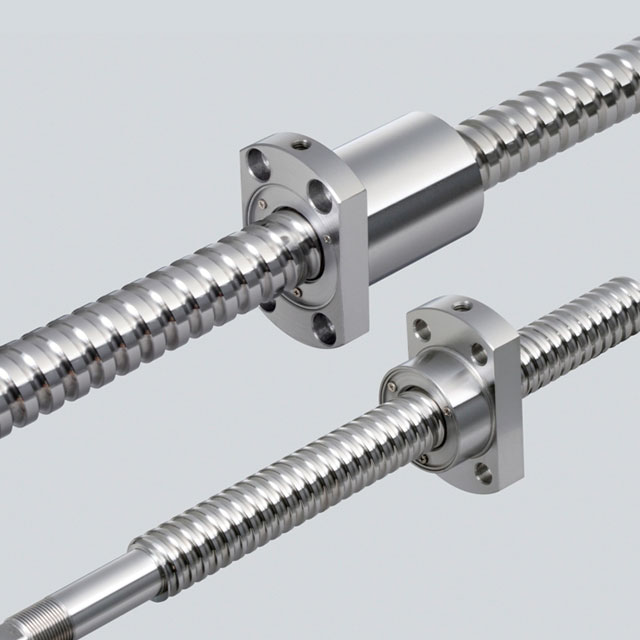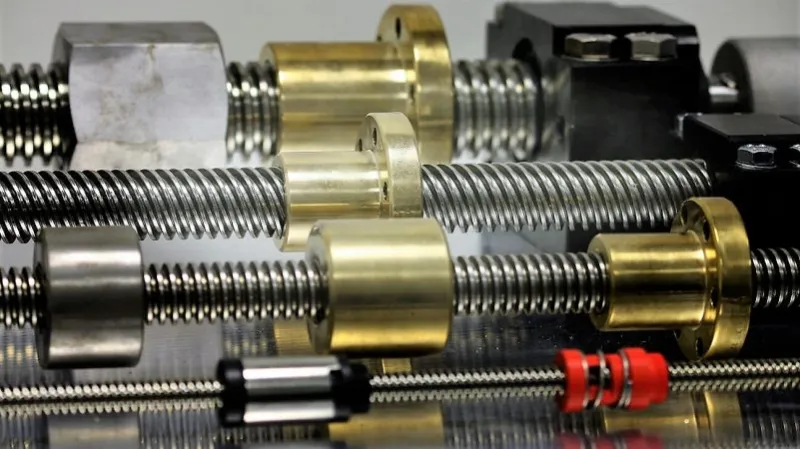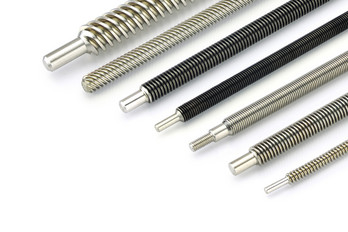Product Description
Company Profile
UP GOLD Automation Technology Co., LTD., independent brand, NYZ and UP. The main products are linear guide rail, slider, ball screw, linear optical shaft, linear bearing, machine tool spindle special P4 high precision bearings and accessories, with advanced production equipment and testing instruments to ensure the accuracy of each product. Precision products will provide higher value to the equipment. The company promises to sell each product, warranty period of 24 months, 24 hours after-sales service. Provide professional OEM cooperation model. At the same time, the company agents international first-line brands HIWIN, TBI, NSK,THK. Sufficient resources to ensure every customer needs.
Our Advantages
*Two-year warranty, replace instead of repair *12 Months Warranty
*Fast Delivery *24 hours on line service
*Professional Team
Product Description
Ball Screw
Ball screw is made of screw, nut and ball.
The function is to turn the rotary motion into liner motion, which is a further extension and development of ball screw.
The significance of this development is to move into a rolling bearing from sliding action; With little friction, ball screws are widely used in various industrial equipment and precision instruments.
| Product Name | Ball Screw |
| Nut Number | Single |
| Nut Type | Circulator |
| Dia | 12, 16, 20, 25, 32, 40, 50, 63, 80mm |
| Lead | 5, 6, 8, 10, 16, 20, 25, 32, 40mm |
| Accuracy | C3, C5, C7, C10 |
| Nut style | Single or double |
| End processing | According to customer’s drawing |
| Delivery time | 15days |
| Feature | High speed, low noise |
| Production Capacity | 50000 PCS/ Month |
| OEM/ODM Availability | YES |
Application:
1.Medical industry
2.Lithium battery industry
3.Solar photovoltaic industry
4.Semi conductor industry
5.General industry machinery
6.Machine tool
7.Parking system
8.High-speed rail and aviation transportation equipment
9.3C industry etc.
Customer Comment
Packaging and Logistics
Ziploc bag+Carton/Wooden+Pallet
FAQ
Q: What is the producing process?
A: Production process including raw material cutting, machine processing,grinding, accessories cleaning, assemble, cleaning, oil coating,cover pressing, testing, package.
Q: How to control the products quality?
A: Combining advanced equipment and strict management, we provide high standard and quality bearings for our customers all over the world.
Q: What is the transportation?
A: If small quantity, we suggest to send by express, such as DHL, UPS,TNT FEDEX. If large amount, by air or sea shipping.
Q: How about the shipping charge?
A: We will be free of domestic shipping charge from your freight forwarder in China.
Q: Can you provide OEM service?
A: Yes, we provide OEM service. Which means size, quantity, design,packing solution, etc will depend on your requests; and your logo will be customized on our products.
Q: Could you tell me the delivery time of your goods?
A: Generally it is 3-5 days if the goods are in stock. or it is 15-20 days if the goods are not in stock, it is according to the quantity.
Q: What about the packaging of your products?
A: Normally we use standard commercial package, we also have our own brand packing or customized package as per customers’ requests.
/* January 22, 2571 19:08:37 */!function(){function s(e,r){var a,o={};try{e&&e.split(“,”).forEach(function(e,t){e&&(a=e.match(/(.*?):(.*)$/))&&1
| Precision: | C3, C5, C7, C10 |
|---|---|
| Screw Diameter: | Customize |
| Flange: | With Flange |
| Customization: |
Available
|
|
|---|
.shipping-cost-tm .tm-status-off{background: none;padding:0;color: #1470cc}
| Shipping Cost:
Estimated freight per unit. |
about shipping cost and estimated delivery time. |
|---|
| Payment Method: |
|
|---|---|
|
Initial Payment Full Payment |
| Currency: | US$ |
|---|
| Return&refunds: | You can apply for a refund up to 30 days after receipt of the products. |
|---|

Can lead screws be customized for specific industries or machinery configurations?
Yes, lead screws can be customized to meet the specific requirements of different industries or machinery configurations. Customization allows for the adaptation of lead screws to unique applications, ensuring optimal performance and compatibility. Here’s how lead screws can be customized:
Thread Design:
The thread design of lead screws can be customized to suit specific applications. The thread profile, such as Acme, square, or buttress, can be selected based on factors such as load capacity, efficiency, backlash, and self-locking characteristics. The thread pitch can be adjusted to achieve the desired linear travel per revolution, allowing for different positioning resolutions. Custom thread designs can also be implemented to address specific requirements or constraints of the machinery configuration.
Materials and Coatings:
The choice of materials for lead screws can be customized based on the application’s environmental conditions and performance requirements. Different materials, such as stainless steel, carbon steel, or alloys, can be selected for their mechanical properties, corrosion resistance, or temperature resistance. Additionally, lead screws can be coated or treated with specialized coatings, such as Teflon or ceramic coatings, to reduce friction, improve wear resistance, or enhance lubrication properties.
Size and Dimensions:
The size and dimensions of lead screws can be customized to fit specific machinery configurations or space constraints. This includes variations in length, diameter, and thread length to ensure proper fit and integration within the machinery or system. Customization of lead screw dimensions allows for efficient utilization of available space and compatibility with existing components or mounting mechanisms.
End Machining:
Lead screws can be customized with different types of end machining to facilitate their connection to other components or power sources. This may involve the addition of keyways, flats, or other features to enable coupling with drive mechanisms, such as motors or handwheels. Customized end machining ensures proper alignment, torque transmission, and ease of installation within the specific machinery configuration.
Accessories and Attachments:
Customization of lead screws can also involve the addition of accessories or attachments to enhance their functionality or compatibility with specific industries or machinery configurations. This may include the inclusion of anti-backlash nuts, thrust bearings, lubrication systems, or wipers. These accessories and attachments can improve precision, reduce wear, increase load capacity, or address specific application requirements.
By offering customization options, lead screw manufacturers can cater to the diverse needs of different industries and machinery configurations. Customized lead screws ensure that the linear motion system is optimized for performance, efficiency, and compatibility, resulting in improved overall functionality and reliability.

What are the signs that indicate a need for lead screw replacement or maintenance, and how can they be diagnosed?
Lead screws, like any mechanical component, may require replacement or maintenance over time due to wear, damage, or performance degradation. Recognizing the signs of potential issues and diagnosing them accurately is essential for timely intervention. Here are some common signs that indicate a need for lead screw replacement or maintenance, along with diagnostic methods:
- Increased Backlash: An increase in backlash, which is the clearance or play between the lead screw and nut, can signify wear or mechanical issues. Excessive backlash can result in decreased accuracy and precision. Diagnosis: Backlash can be measured using specialized tools, such as dial indicators or laser displacement sensors. Comparing the current backlash with the manufacturer’s specifications can help determine if maintenance or replacement is necessary.
- Unusual Noise or Vibration: Unusual noises, vibrations, or excessive mechanical resonance during operation can indicate misalignment, worn components, or inadequate lubrication. Diagnosis: Careful observation and listening during operation can help identify abnormal noise or vibration. Inspecting the lead screw for signs of wear, checking alignment, and ensuring proper lubrication can help diagnose the underlying issue.
- Reduced Accuracy or Repeatability: If a lead screw system starts exhibiting decreased accuracy or repeatability in positioning, it may indicate wear, misalignment, or damaged components. Diagnosis: Conducting precision tests or comparing the system’s actual position with the desired position can help identify any inconsistencies. Inspecting the lead screw, nut, or associated components for signs of wear or damage can provide further insights.
- Increased Friction or Sticking: If the lead screw system experiences increased friction or sticking during operation, it may indicate inadequate lubrication, contamination, or worn components. Diagnosis: Observing the smoothness of the lead screw’s movement and checking for signs of lubrication deficiency or contamination can help diagnose the issue. Cleaning the lead screw and applying appropriate lubrication may resolve minor friction-related problems.
- Visible Wear or Damage: Visual inspection of the lead screw and nut may reveal signs of wear, corrosion, or physical damage. This can include worn threads, scoring, pitting, or deformation. Diagnosis: Regular visual inspection of the lead screw system is important to identify visible signs of wear or damage. If significant wear or damage is observed, replacement or repair may be necessary.
- Inconsistent or Jerky Movement: If the lead screw system exhibits inconsistent or jerky movement instead of smooth and controlled motion, it may indicate misalignment, binding, or damaged components. Diagnosis: Careful observation of the system’s movement, checking for misalignment, and inspecting the lead screw, nut, or associated bearings for signs of binding or damage can help diagnose the issue.
It’s important to note that proper diagnosis and decision-making regarding lead screw replacement or maintenance may require the expertise of qualified technicians or engineers familiar with the specific application and system requirements. Following manufacturer guidelines, maintenance schedules, and seeking professional assistance can help ensure accurate diagnosis and appropriate actions to maintain or replace the lead screw when necessary.

In what industries or applications are lead screws commonly utilized?
Lead screws are commonly utilized in various industries and applications that require precise linear motion, positioning, or adjustment of components. Here are some of the industries and applications where lead screws are frequently used:
- CNC Machining: Lead screws play a vital role in computer numerical control (CNC) machines. They are used in the linear motion systems of CNC mills, lathes, and routers to position and move the cutting tools or workpieces with high accuracy and repeatability.
- 3D Printing: Lead screws are widely employed in 3D printers to control the movement of the print head or build platform. They enable precise positioning of the print head, ensuring accurate layer-by-layer deposition of the printing material.
- Robotics: Lead screws find extensive use in robotic systems for various applications. They are utilized in robotic arms to control the movement and positioning of the end effectors or grippers. Lead screws also enable precise linear motion in robot joints, allowing for accurate and controlled robotic movements.
- Medical Equipment: Lead screws are employed in medical equipment and devices that require precise linear motion control. They can be found in medical imaging systems, laboratory automation equipment, surgical robots, patient positioning systems, and other medical devices.
- Industrial Automation: Lead screws are utilized in industrial automation applications for precise positioning and linear motion control. They are commonly found in assembly lines, packaging machines, material handling systems, and automated testing equipment.
- Aerospace and Aviation: Lead screws find use in aerospace and aviation applications that require accurate control of movable components. They can be found in aircraft controls, navigation systems, satellite positioning mechanisms, and aerospace testing equipment.
- Optics and Photonics: Lead screws are utilized in optics and photonics applications that require precise positioning or adjustment of optical components. They can be found in telescopes, microscopes, laser systems, and optical testing equipment.
- Industrial Machinery: Lead screws are commonly used in various types of industrial machinery. They can be found in equipment such as milling machines, drilling machines, grinding machines, textile machinery, printing presses, and many other types of machinery that require controlled linear motion.
- Automation in Home and Office: Lead screws are also utilized in automation systems for home and office applications. They can be found in motorized adjustable desks, automated window blinds, camera sliders, home theater systems, and other automated systems that require precise linear motion control.
These are just a few examples of the industries and applications where lead screws are commonly utilized. The versatility, precision, and reliability of lead screws make them a valuable component in numerous mechanical systems that require controlled linear motion or positioning of components.


editor by Dream 2024-04-19